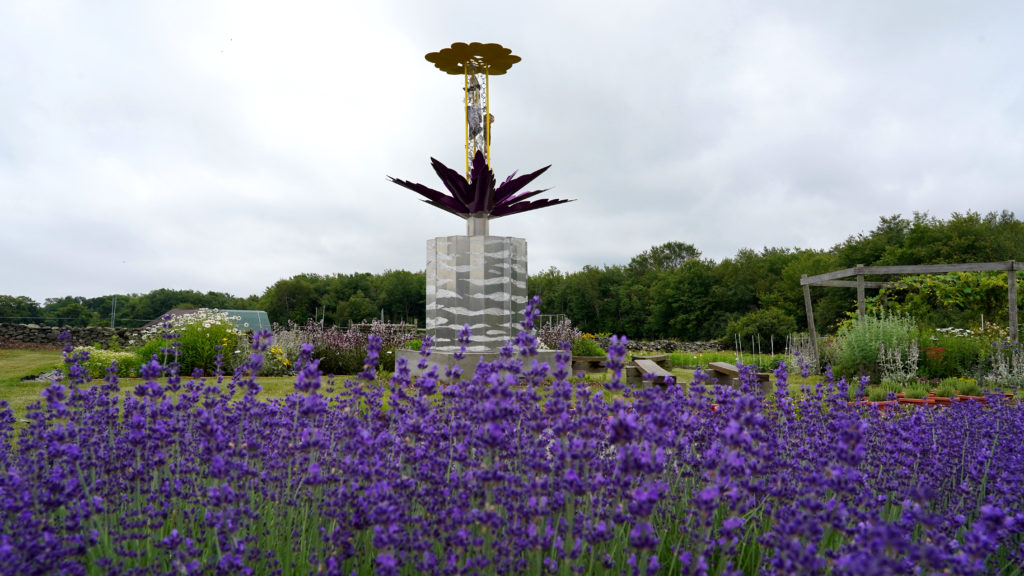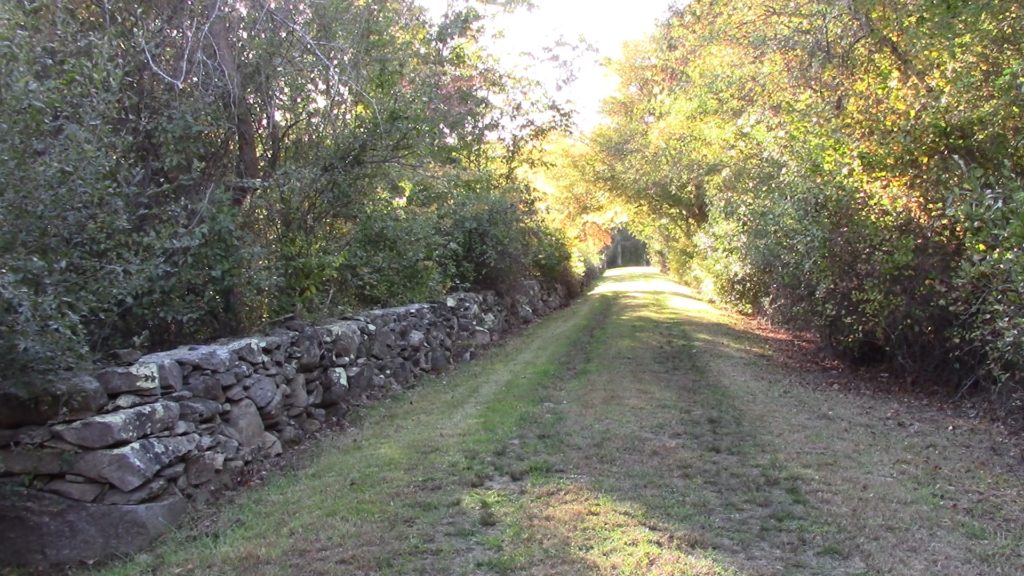 Casey Farm
Casey Farm
"Three Sisters:" RainKeep Sculpture
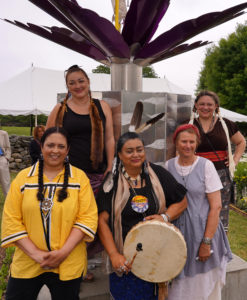
What is that tall feature rising above the stone wall in the garden? A shower of shining stars? A giant psychedelic flower? When you get up close you will see that shiny aluminum, yellow, and purple sight to behold is a modern sculpture in the farm landscape titled Three Sisters: RainKeep. The piece is not only an embellishment, it is the most gorgeous rainbarrel we have ever seen. And, more than that, it tells the Eastern Woodlands creation story of the Three Sisters—corn, beans, and squash—which you will see growing nearby in season.
The yellow upper canopy collects the dew and the rain, which flows down the chain past aluminum figures into a purple floral-form collector whose petals guide the water into a 500-gallon rain barrel. Our gardeners and children at farm programs draw water from its spigot to nurture the garden beds, even as they absorb the story it tells. The work of art calls attention to and honors the Indigenous heritage of the land and the lessons of sustainability and harmony with nature that heritage teaches.
The sculpture made in 2020 is the result of a collaboration between two artists, Allison Newsome and Deborah Spears Moorehead. Newsome is an internationally acclaimed artist based in Warren, Rhode Island, who describes herself as a “functional sculptor.” Her nature-inspired pieces are her reaction to climate change and one solution for providing water for growing things sustainably. Three Sisters is one of the sculptures in her patented RainKeep series, and we couldn’t be more proud to make it the first permanent modern outdoor sculpture in the collection of Historic New England. Moorehead said that “My art, songs, stories, performances and literary works serve to assert, promote, value and validate the identity of the past, present and future generations of Eastern woodland Native American Tribal Nations.” This visual and performing artist drew upon her cultural heritage to create figures of the Sky Woman and others in the creation story of the Three Sisters that were translated through the repoussé technique into aluminum charms by Newsome.
After conducting archaeology to make sure we were not disturbing Indigenous cultural objects, the base and then the sculpture were installed in the Spring of 2021. Each time you see it, we hope you will notice how the work of art changes as it plays with the sky above and growing things around it, and how it sparks imaginations and conversations.
Many Gardens to Visit
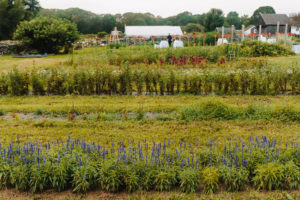
The first recorded garden in the archives is the “sasyard” from Silas Casey’s eighteenth century papers. A derivation of “sauce yard,” this was a kitchen garden close to the location of the first farm house on the property, now marked only by a well. Here is still where our CSA members cut flowers and herbs and where we grow a nice variety of seasonal vegetables for education program participants. It is still surrounded by the same wall Silas Casey saw.
The Education Garden
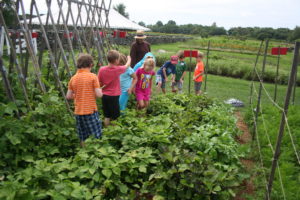 The Education Team plants and tends this garden and teaches children how to do the same. Connecting children to their food sources with hands-on experiences encourages healthy eating habits and an awareness of eating what is in season, the benefits of organic growing, and the pride in growing something. Much of the produce is consumed as snacks for kids or demonstration cooking. Kids and grown-ups even learn the medicinal properties of herbs in this garden. If you visit on a tour, you might just get invited to pick a sample for yourself.
The Education Team plants and tends this garden and teaches children how to do the same. Connecting children to their food sources with hands-on experiences encourages healthy eating habits and an awareness of eating what is in season, the benefits of organic growing, and the pride in growing something. Much of the produce is consumed as snacks for kids or demonstration cooking. Kids and grown-ups even learn the medicinal properties of herbs in this garden. If you visit on a tour, you might just get invited to pick a sample for yourself.
The CSA Garden
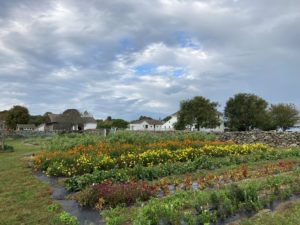 The Farm Crew plans and cares for this garden for the benefit of the Community Supported Agriculture members. The rows of flowers are part of the farm share, and many of the people working here get a share in return for their labor, called workshares. For several years our head gardener has been Sheila Nixon, who is multi-talented as a tour guide and farm teacher, too. It is labor of love, to be sure—and a garden full of love is a good place to get married! Please don’t pick from the ornamental beds around the pergola because those are for the lovebirds.
The Farm Crew plans and cares for this garden for the benefit of the Community Supported Agriculture members. The rows of flowers are part of the farm share, and many of the people working here get a share in return for their labor, called workshares. For several years our head gardener has been Sheila Nixon, who is multi-talented as a tour guide and farm teacher, too. It is labor of love, to be sure—and a garden full of love is a good place to get married! Please don’t pick from the ornamental beds around the pergola because those are for the lovebirds.
Pollinator Gardens
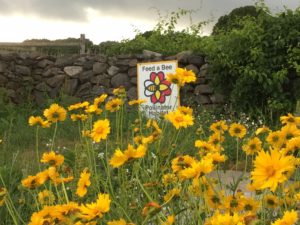 One could argue that all of Casey Farm is a pollinator paradise, because we use no pesticides and grow so many plants here. Still, we all know that pollinator insects are the key to producing food, and supporting their health is vital. Plus, the workshare-supported beehives on the property produce delicious honey! We have long maintained parts of the property with meadows of native plants that are the bee’s knees to pollinators. The volunteers from the Pollinator Rescue Project of Rhode Island added an even more diverse array as a demonstration garden just adjacent to the parking area so everyone coming to visit can linger and learn.
One could argue that all of Casey Farm is a pollinator paradise, because we use no pesticides and grow so many plants here. Still, we all know that pollinator insects are the key to producing food, and supporting their health is vital. Plus, the workshare-supported beehives on the property produce delicious honey! We have long maintained parts of the property with meadows of native plants that are the bee’s knees to pollinators. The volunteers from the Pollinator Rescue Project of Rhode Island added an even more diverse array as a demonstration garden just adjacent to the parking area so everyone coming to visit can linger and learn.
Ornamental Beds
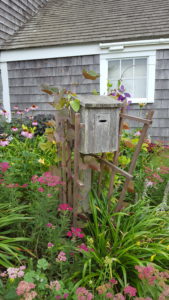 Tucked beside the stone walls, near the old woodshed, near the Share Barn, and everywhere you look are an ever-changing display of blooms that our garden volunteers and workshares have spent many hours cultivating. Their expertise and passion shows!
Tucked beside the stone walls, near the old woodshed, near the Share Barn, and everywhere you look are an ever-changing display of blooms that our garden volunteers and workshares have spent many hours cultivating. Their expertise and passion shows!
Gardens at Casey Farm
Bright Oriental poppies are the star of the show each June in the front lawn perennial beds.
Stone Walls and Gardens
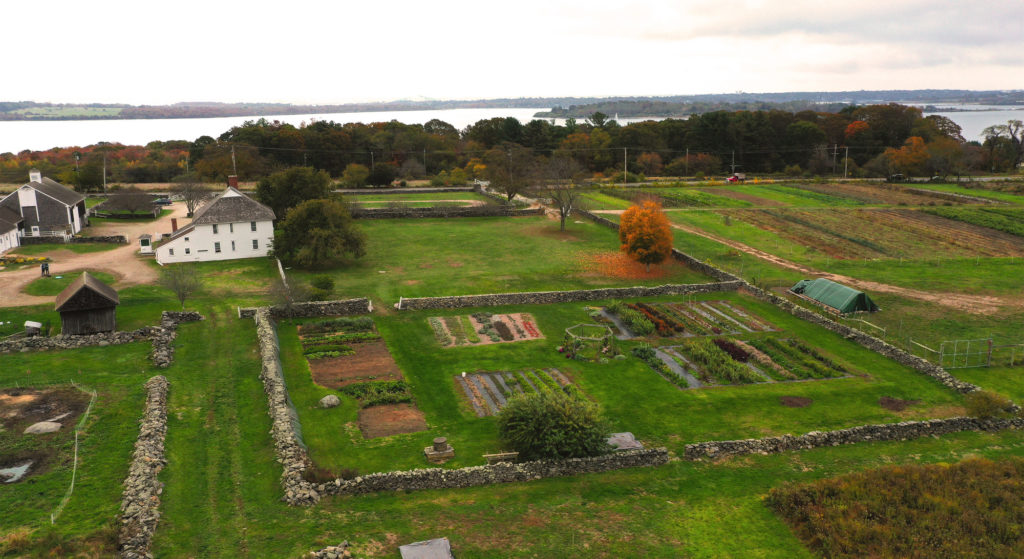
Casey Farm’s three hundred acres are lined with more than ten miles of stone walls. Each day, through the changing weather, the walls are a gorgeous sight and frame spectacular views. Walls define how we move around the farm, shelter us from the wind, and hold in warmth or coolness. They help protect the farm animals and the crops, and make the gardens bloom longer.
At first, stone walls were just what happened once colonists deforested the land and the glacial stones underneath made their way to the surface—they had to be hauled into piles. Those piles of stones eventually helped to define fields, boundaries, and roadways. Often, in the wintertime, farmhands took time to balance the stones into more enduring structures and protect gardens and cemeteries from livestock. In Southern Rhode Island, cows, horses, and sheep were big business, so walls needed to be at least five feet tall to keep herds from climbing over them and to protect the livestock from predators. More than that, these walls were a great way to show off. The fancy walls near the farmhouse are fitted with two sides of carefully balanced stones with smaller fill in between, then topped by huge flat rocks. Only construction skill and gravity keep them standing.
Stone Wall Perspectives
by Lorén M. Spears, Executive Director, Tomaquag MuseumWho Built the Walls?
Similar to most Southern Rhode Island plantations, we have some documentation linking Casey Farm to slavery in the eighteenth century. Though none of the documents link the labor of enslaved people to building stone walls, it is plausible that enslaved African-Americans and Native Americans may have been involved. We intend that further research will shed some light on these questions.
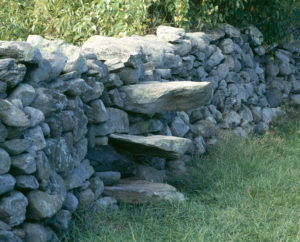
There is documentation in the Casey Family papers linking three different late-eighteenth century tenant farmers and a hired hand with wall construction. One of these people, Cezar Northup, was a free person of color, and several of his family members worked as farmhands.
Farm records tell us that one tenant farmer in the 1780s, Reynolds Knowles, built more than nine hundred feet of five-foot-tall walls around the barnyard and pastures in return for 650 pounds of Narragansett cheese! Back then this kind of cheese was a valuable commodity that Knowles could trade or sell.
Casey Farm’s dry-laid stone walls still stand today, including some built by Reynolds Knowles around the “sasyard,” the kitchen garden. Even with the best stewardship, animals, weather, and people will inevitably cause damage to stone walls and several repair campaigns had been done over the years. By 2019, the walls in the most heavily visited public areas at Casey Farm near the farm house and barnyard needed several repairs.
Stone Wall Repairs
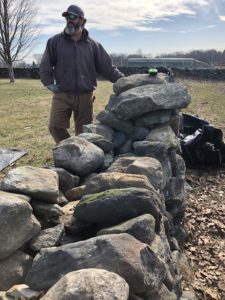
Through the generosity of donors and private foundations, Historic New England hired Mike Minto of Rhode Island Stone Walls to repair about seventy-five percent of these walls under the direction of our preservation manager, Margaret Back. The work started in October 2019 and was completed just before our sites had to temporarily close to the public due to the pandemic in March of 2020. It is solitary work anyway, and Mike only needed the occasional assistance of a farmer driving a tractor for the largest stones. Mike is a master at his art with a deep understanding of how these walls were built, and it was amazing to see him dismantle the damaged walls and rebuild them largely by hand.
Deep inside the wall dividing the farmhouse lawn from the garden (the one Reynolds Knowles had built), Mike found bricks that match the c. 1750 bricks in the central chimney of the farmhouse. He also found some wrought iron 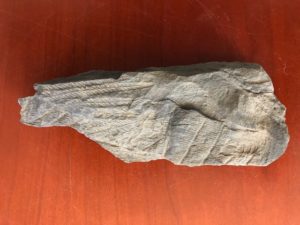 nails and pottery, giving us a good idea that this part of the wall hadn’t been taken apart for three centuries or so. One of the best finds was this small rock used as infill in the garden wall. The gray shale was imprinted with fossils! A little help from our friends at the Natural History Museum and Planetarium in Roger Williams Park identified the plants as tree ferns, which were common in the tropical forests of 300 million years ago. The stone walls have many stories to tell.
nails and pottery, giving us a good idea that this part of the wall hadn’t been taken apart for three centuries or so. One of the best finds was this small rock used as infill in the garden wall. The gray shale was imprinted with fossils! A little help from our friends at the Natural History Museum and Planetarium in Roger Williams Park identified the plants as tree ferns, which were common in the tropical forests of 300 million years ago. The stone walls have many stories to tell.
